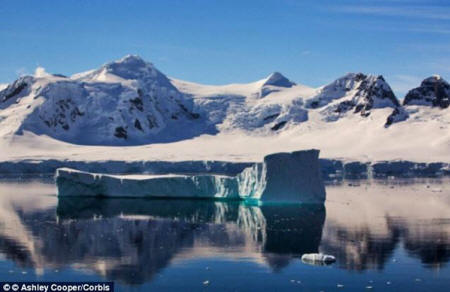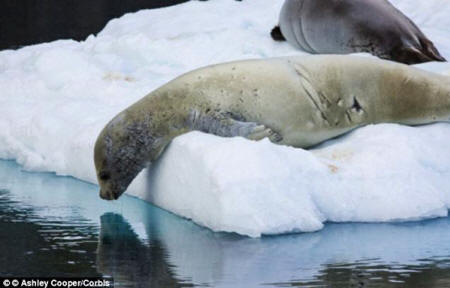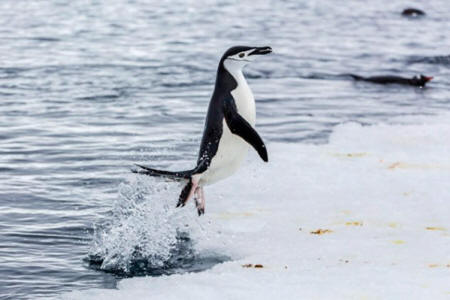If climate-change scientists ever want to put their global-warming predictions on ice, they can find plenty of it down around the South Pole. Antarctic sea ice has reached a new record high, with 2.1 million square miles more than usual for this time of year, the Daily Mail in England reported Sunday.
According to the U.S. National Snow and Ice Data Center, Antarctic ice now covers about 16 million square miles.
The expansion means,
"an area the size of Greenland, which would normally be open water, is now frozen," the Daily Mail said.
"It is by far the highest level since satellite observations on which the figures depend began in 1979," wrote reporter David Rose, who called the discrepancy between the expanding ice and computer-based predictions that sea ice would be receding from both poles "yet another mishap to tarnish the credibility of climate science."
David Rose conceded that ice is receding in the Arctic Ocean at the North Pole, but added that the frozen area around both poles is one million square kilometers more than "the long-term average."
"In fact, across the globe, there are about one million square kilometers more sea ice than 35 years ago, which is when satellite measurements began," Rose wrote.
"We do not have a quantitative, predictive understanding of the rise in Antarctic sea ice extent," Professor Judith Curry, head of climate science at the Georgia Institute of Technology in Atlanta, told the Daily Mail.
"Convincing arguments regarding the causes of sea-ice variations require understanding and ability to model both the Arctic and Antarctic," she said.
Computer-based models tend to assume a continuation of contemporary trends, and forecasters basing their predictions on those models are unable to take into account unanticipated pauses and reversals of trends.
According to Rose, the computer models,
"have long been the subject of ridicule because of their stunning failure to predict the pause in warming - nearly 18 years long on some measures - since the turn of the last century."
But a competing London daily offers contrary views of the levels of sea ice and the global-warming controversy.
"The Daily Mail tries to distract from global warming by selectively looking southward," John Abraham and Daniel Nuccitelli of the The Guardian wrote on Monday.
"What's causing Antarctic sea ice to increase is an interesting scientific question," they said.
"After all, the Antarctic region is warming, including its oceans. As a result, two recent studies concluded that the collapse of the Western Antarctic ice sheet is already underway and is unstoppable."
Theories advanced to explain the expansion of Antarctic sea ice, they wrote, include the possibility that,
"the influx of cold fresh water from melting Antarctic ice shelves may be contributing to the increase in Antarctic sea ice. Others argue the increase can be explained by natural variability," though that could also be a reason for melting trends.
Another possibility is error in satellite measurements, though John Abraham and Daniel Nuccitelli concede that explanation "seems unlikely."
An article appearing in the Washington Post last month suggested the answer might be in a,
"westerly wind belt that encircles Antarctica in the Southern Ocean."
The Southern Annular Mode, also called the "Antarctic Oscillation," pushes the winds northward from the South Pole.
As the winds encounter more sea ice they push it northward, increasing the area covered by the ice. Ozone depletion and the increase in greenhouse gases since the 1940s, according to this theory, have increased the intensity of the winds and caused them to migrate toward Antarctica.
Data supporting measurements and projections of climate change have long been disputed, most notably during the "Climategate" scandal that erupted in 2009 when a hacker copied thousands of e-mails and computer files from the Climatic Research Unit at the University of East Anglia that indicated efforts to manipulate the findings to support climate-change theories and discredit critics.
Spokesmen for the research unit claimed the accusations were based on statements taken out of context and that the communications were part of an honest exchange of ideas.
In recent days a new scandal has arisen "over the integrity of temperature data in America," Rose wrote, with the discovery that many temperature stations have been closed and their findings replaced by estimates of temperatures based on records from surrounding stations.
"So vast swathes of the data are actually from 'zombie' stations that have long since disappeared," Rose wrote.
"This is bad enough, but it has also been discovered that the US's National Oceanic and Atmospheric Administration is using estimates even when perfectly good raw data is available to it - and that it has adjusted historical records."
Those adjustments have produced data showing,
"a warmer present and a colder past, with the net result being the impression of much faster warming," Rose charged.
Such efforts are,
"unlikely to greatly affect our overall picture of rising temperatures at the end of the last century and a standstill thereafter," he wrote.
"The US is, after all, only a small proportion of the globe."
Abraham and Nuccitelli argue that the statistical technique for estimates where no temperature station is available,
"has been confirmed by the Koch-funded Berkeley Earth Surface Temperature group. The accuracy of the surface temperature record has been proven over and over and over again. Continuing to deny its accuracy by manufacturing 'scandals' is, well, denial," they say.
The terms "denial" and "deniers" are often used by believers in man-made global warming to imply that a cause-and-effect relationship between carbon emissions and climate change is an indisputable fact and that "deniers" are out of touch with reality, like members of the Flat Earth Society.
Yet time and again numbers of reputable scientists have questioned the data and conclusions of those claiming the evidence of man-made climate change is overwhelming and undeniable on the basis of facts.
In 2011, Dr. Ivar Giaever, a former professor with Rensselaer Polytechnic Institute and the 1973 winner of the Nobel Prize in physics, announced his resignation from the American Physical Society in protest over what he claimed was the refusal by the APS to countenance debate over the conclusion that global warming is both a man-made phenomenon and a looming catastrophe.
"In the APS it is ok to discuss whether the mass of the proton changes over time and how a multi-universe behaves, but the evidence of global warming is incontrovertible?"
Dr. Giaever asked in the e-mail he sent announcing his resignation.
The claim of temperature increases of less than one degree over 150 years,
"means to me that the temperature has been amazingly stable, and both human health and happiness have definitely improved in this 'warming' period," he wrote.
The following year 49 former top National Aeronautics and Space Administration scientists and astronauts released a letter they had sent to NASA administrator Charles Bolden stating that claims that,
"man-made carbon dioxide is having a catastrophic impact on global climate change are not substantiated."
Patrick Moore, a Ph.D. in ecology and co-founder of the environmental group Greenpeace, told a panel of the U.S. Senate earlier this year:
"There is no scientific proof that human emissions of carbon dioxide (CO2) are the dominant cause of the minor warming of the Earth's atmosphere over the past 100 years.
Today, we live in an unusually cold period in the history of life on earth and there is no reason to believe that a warmer climate would be anything but beneficial for humans and the majority of other species."
Last year, a peer-reviewed survey of 1,077 geo-scientists and engineers, published in Organization Studies, found that just 36 percent believe that humans are creating a global-warming crisis.
A solid majority - 56 percent - expressed the view that natural causes are the primary contributors to global warming and that future warming does not pose a serious problem.
Yet President Obama, employing what the New York Times described as "gleefully sarcastic terms" in a June 14 commencement address at the University of California-Irvine, likened dissenters on climate change to people who would have said in the early days of America's space program that the moon, "was made of cheese."
Members of Congress who oppose his plan for curbing carbon emissions know the truth, he said, but are afraid of being,
"run out of town by a radical fringe that thinks climate science is a liberal plot."
"I'm not a scientist either," the president conceded, "but we've got some good ones at NASA. I do know the overwhelming majority of scientists who work on climate change, including some who once disputed the data, have put the debate to rest."
The debate seems rather loud and intense for one that has been put to rest.
"But when a politician on a subject implicating science, hard science, economic science, social science says the debate is over, you may be sure of two things," columnist George Will observed on a recent edition of Fox News Sunday.
"The debate is raging and he's losing it."
|
|
Antarctic Sea Ice Hits New Record High
- 2.1 Million Square Miles More than is Usual for Time of Year -
Global Warming Computer Models Confounded
by David Rose
5 July 2014
from
DailyMail Website
Ice is covering 16m sq km,
more than 2.1m unusual for time of year.
UN computer models say
Antarctic ice should be in
'decline,' not increasing.
The levels of Antarctic sea-ice last week hit an all-time high -
confounding climate change computer models which say it should
be in decline.
America's National Snow And Ice Data Center, which is
funded by NASA, revealed that ice around the southern continent
covers about 16 million sq/km, more than 2.1 million more than is
usual for the time of year.
It is by far the highest level since satellite observations on
which the figures depend began in 1979.
In statistical terms, the extent of the ice cover is hugely
significant.

The Gerlache Strait separating the Palmer Archipelago
from the
Antarctic Peninsular off Anvers Island
It represents the latest stage in a trend that started ten years
ago, and means that an area the size of Greenland, which would
normally be open water, is now frozen.
The Antarctic surge is so big that overall, although Arctic ice
has decreased, the frozen area around both poles is one million
square kilometers more than the long-term average.
In its authoritative
Fifth Assessment Report released last year,
the UN Intergovernmental Panel on Climate Change admitted that
the computer models on which scientists base their projections
say Antarctic ice should be in decline, not increasing.
The report said:
'There is low confidence in the scientific understanding of the observed increase in Antarctic sea ice extent since 1979, due to… incomplete and competing scientific explanations for the causes of change.'
jumps out of the
sea at Port Lockroy, Antarctica

A Crabeater seal on an iceberg in Paradise Bay, Antarctica.
Crabeater seals are the most common
large mammal on the planet after humans,
with an estimated population of 15 million
NASA animation shows Antarctic ice
sheet melting
|
|
Some scientists have suggested the Antarctic ice increase may
itself be caused by global warming. But Professor Judith
Curry, head of climate science at the Georgia Institute of
Technology in Atlanta, said the arguments were not convincing.
She added:
'We do not have a quantitative, predictive understanding of the rise in Antarctic sea ice extent.'
She said it was becoming
increasingly apparent that long-term cycles in ocean
temperatures were responsible for a significant proportion of
the ice decline in the Arctic - a process that may be starting
to reverse.
Prof Curry also revealed that because of the 'pause', in which
world average temperatures have not risen for more than 16
years, the Arctic ice decline has been 'touted' by many as the
most important evidence for continued global warming.
But in her view, climate scientists have to consider evidence
from both Poles.
She added:
'Convincing arguments regarding the causes of sea-ice variations require understanding and ability to model both the Arctic and Antarctic.'
***
IT'S POLITICS, NOT SCIENCE, DRIVING CLIMATE CHANGE MANIA
by Andrew Mountford
5 July 2014
For years, computer simulations have predicted that sea ice should be disappearing from the Poles.
Now, with the news that Antarctic sea-ice levels have hit new highs, comes yet another mishap to tarnish the credibility of climate science. Climatologists base their doom-laden predictions of the Earth's climate on computer simulations.
But these have long been the subject of ridicule because of their stunning failure to predict the pause in warming - nearly 18 years long on some measures - since the turn of the last century.
It's the same with sea ice. We hear a great deal about the decline in Arctic sea ice, in line with or even ahead of predictions.
But why are environmentalists and scientists so much less keen to discuss the long-term increase in the southern hemisphere?
In fact, across the globe, there are about one million square kilometers more sea ice than 35 years ago, which is when satellite measurements began.
It's fair to say that this has been something of an embarrassment for climate modelers. But it doesn't stop there.
In recent days a new scandal over the integrity of temperature data has emerged, this time in America, where it has been revealed as much as 40 per cent of temperature data there are not real thermometer readings.
Many temperature stations have closed, but rather than stop recording data from these posts, the authorities have taken the remarkable step of 'estimating' temperatures based on the records of surrounding stations.
So vast swathes of the data are actually from 'zombie' stations that have long since disappeared.
This is bad enough, but it has also been discovered that the US's National Oceanic and Atmospheric Administration is using estimates even when perfectly good raw data is available to it - and that it has adjusted historical records.
Why should it do this?
Many have noted that the effect of all these changes is to produce a warmer present and a colder past, with the net result being the impression of much faster warming. They draw their conclusions accordingly.
Naturally, if the US temperature records are indeed found to have been manipulated, this is unlikely to greatly affect our overall picture of rising temperatures at the end of the last century and a standstill thereafter. The US is, after all, only a small proportion of the globe.
Similarly, climatologists' difficulties with the sea ice may be of little scientific significance in the greater scheme of things.
We have only a few decades of data, and in climate terms this is probably too short to demonstrate that either the Antarctic increase or the Arctic decrease is anything other than natural variability.
But the relentless focus by activist scientists on the Arctic decline does suggest a political imperative rather than a scientific one - and when put together with the story of the US temperature records, it's hard to avoid the impression that what the public is being told is less than the unvarnished truth.
As their credulity is stretched more and more, the public will - quite rightly - treat demands for action with increasing caution…



